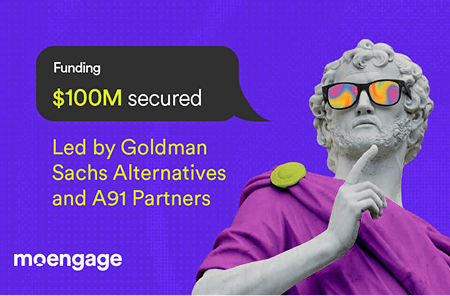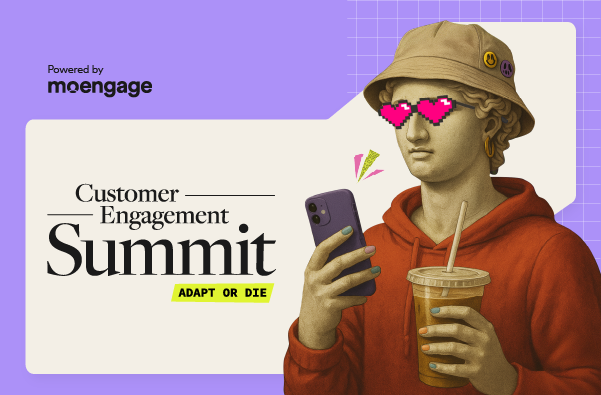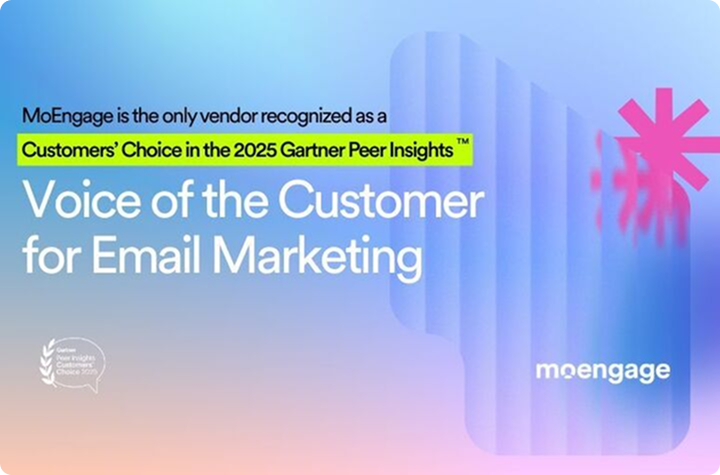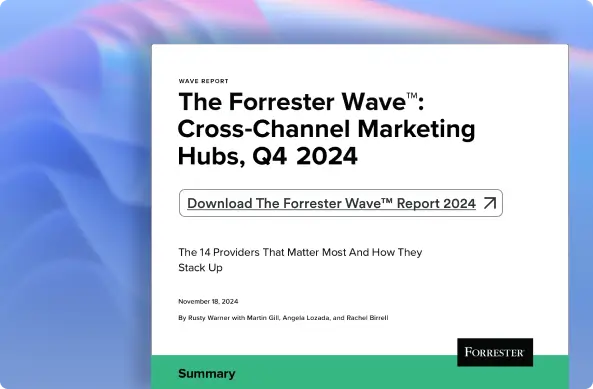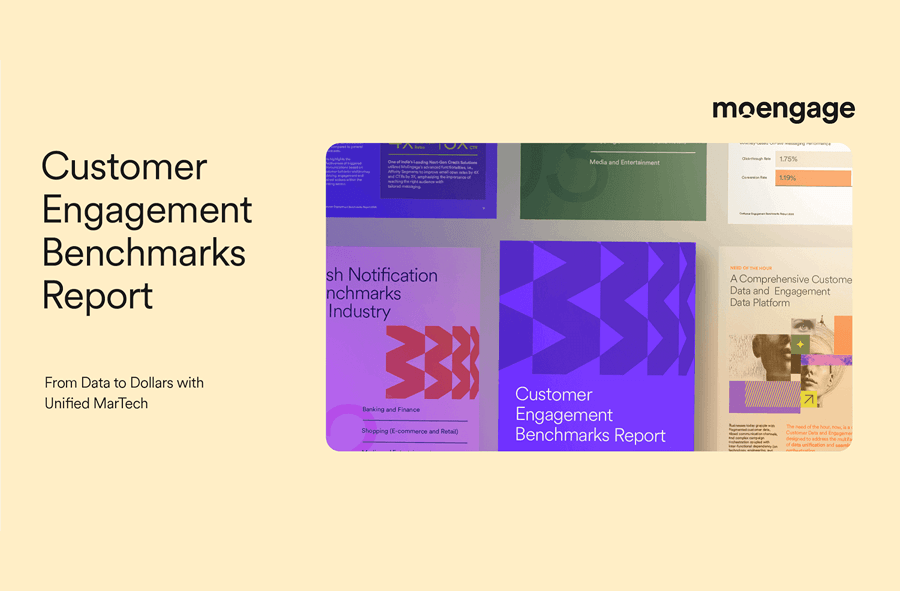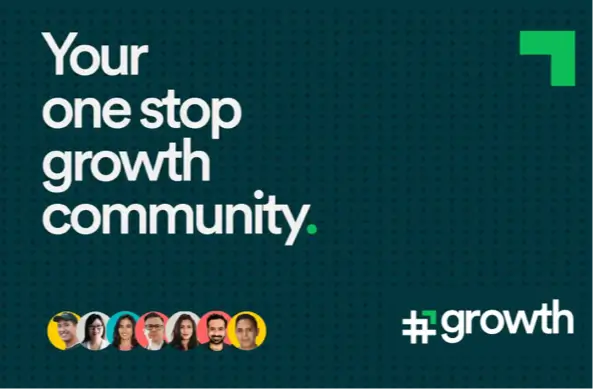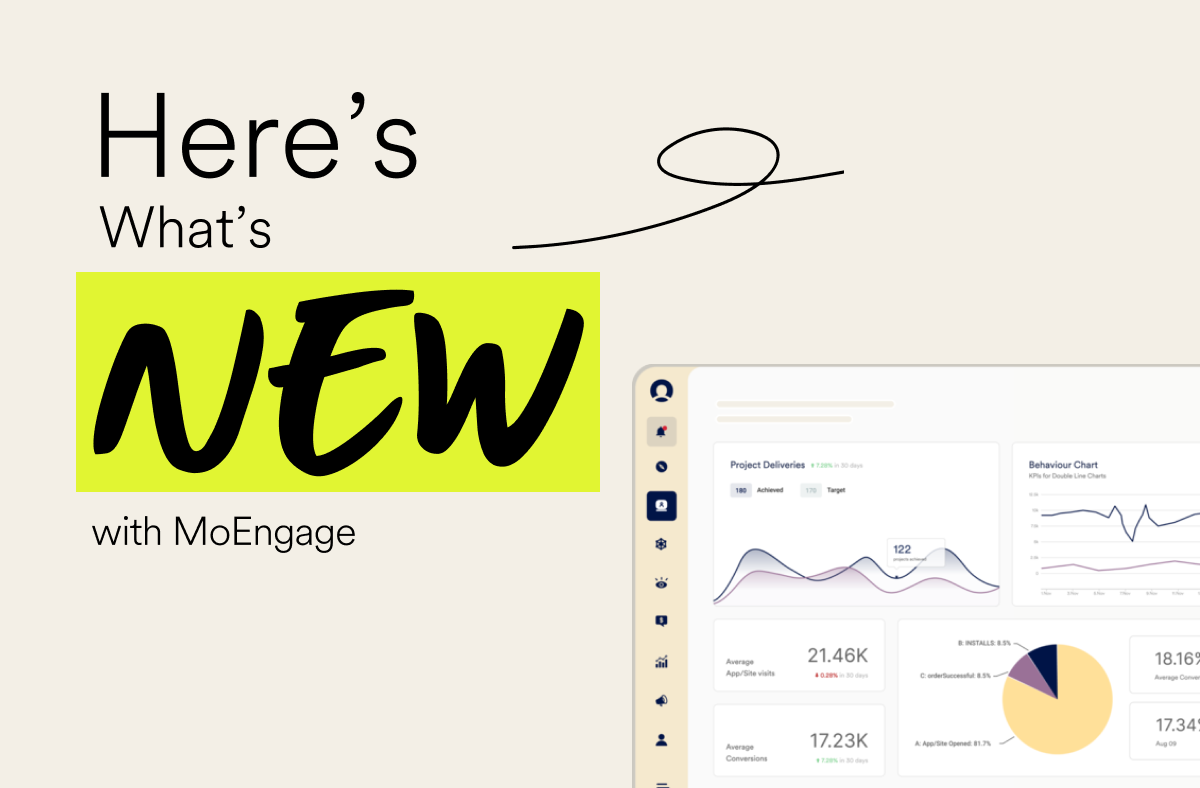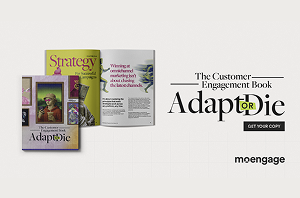AI in Customer Engagement: Tools, Trends and Benefits
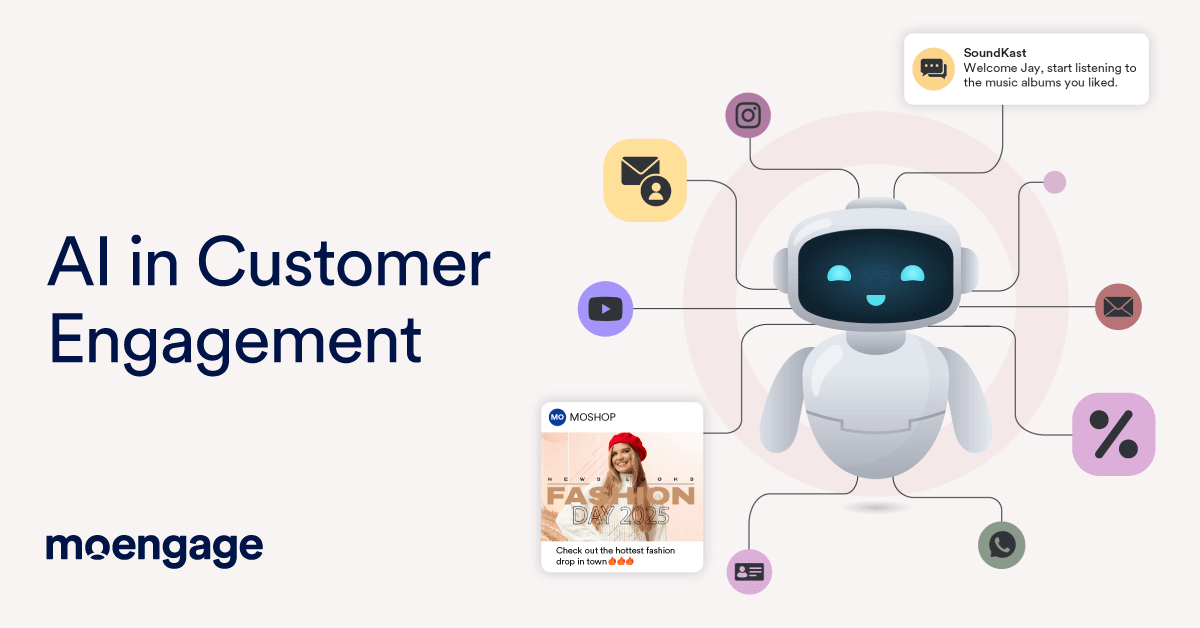
Reading Time: 17 minutes
AI in customer engagement is ripping apart the old B2C marketing playbook. With AI, you can see exactly how your customers behave, predict what they want, and deliver personalized customer experiences the moment they’re ready to buy or leave.
But what’s the big deal? Well, after adopting AI for their customer engagement efforts, 71% of marketers have seen better data-driven customer insights, according to Gartner. 56% of marketers report that their lead generation has improved, while 47% have noticed higher customer satisfaction scores.
The ‘why’ is clear: less manual grind for teams, and more relevance for customers. In this blog post, we’ll explore the trends shaping the use of AI in customer engagement, the benefits it offers, and the tools driving its adoption.
9 Ways AI is Used in Customer Engagement
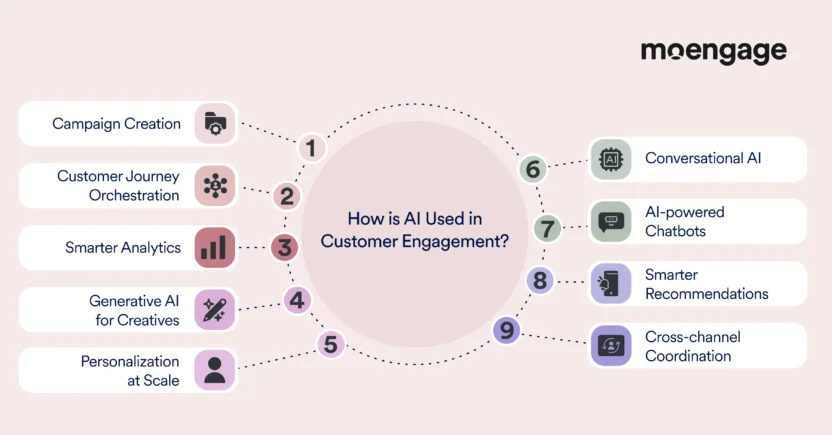
What used to take marketers hours, like figuring out who to target, when to send a message, or how to personalize content, can now be done in minutes with AI customer engagement tools.
Today, AI helps brands not only plan campaigns, but also guide customers along their journey, surface insights from data, and deliver personalization at scale.
The result? Smarter, faster, and more relevant experiences across every channel.
Here are some of the most impactful ways AI is transforming customer engagement right now:
1. Campaign creation
Creating campaigns can involve quite a bit of manual work. You have to segment customers, write copy, pick the right channels, and figure out the best send times for messages. AI customer engagement tools make this much easier. You can start with something as simple as, “Reach out to customers who abandoned their carts last week,” and the AI can:
- Build the right customer segments in seconds without complicated filters
- Draft multiple versions of your copy for email, push, and SMS
- Suggest the best send times and channels based on past engagement
Generative AI can even help with creative brainstorming, offering different subject lines, CTAs, or promotional copy so you don’t have to make everything from scratch. This speeds up the whole process and gives you room to experiment. Plus, AI helps keep your messaging consistent across channels, so emails, push notifications, and in-app messages all feel coordinated and seamless.
2. Customer journey orchestration
Mapping multi-step, omnichannel journeys is often complex, especially when tailoring experiences for each customer. AI simplifies this by translating high-level goals into detailed, optimized journeys. For instance, telling AI, “Onboard new customers with a welcome series,” can result in:
- Suggested touchpoints across email, push, in-app, and SMS
- Personalized timing and content at each step
- Real-time adjustments as customers interact with your campaigns
Instead of manually building branching flows, AI predicts the most effective path for each customer, making the journey feel seamless and highly personalized. This real-time customer journey orchestration improves engagement and reduces friction, ensuring customers receive the right message at the right time, no matter the channel.
3. Smarter analytics
AI in customer engagement isn’t just about sending messages. It’s also about ensuring marketers have access to smarter, actionable analytics. Instead of manually sifting through dashboards, marketers can now ask questions in plain language, like “Which segment has the highest cart abandonment rate?” or “Which products are driving repeat purchases?”
Behind the scenes, AI performs data querying, which means it automatically pulls the relevant metrics from your customer data without you having to know complex filters or SQL.
At the same time, it continuously conducts data monitoring, keeping an eye out for unusual trends or sudden drops in performance, like a spike in abandoned carts or a dip in email engagement.
Once it identifies patterns or anomalies, AI explains the findings in simple terms, helping teams understand not just what happened, but why it happened. This approach moves marketers from reacting to reports after the fact to proactively optimizing campaigns in real time. It also supports cross-channel optimization, showing which channels perform best for different segments and ensuring your efforts are focused where they will have the most impact.
4. Generative AI for creatives
Creating campaign assets used to be a time-consuming process, involving hours of brainstorming, writing multiple versions of copy, and designing layouts for different segments. Generative AI changes all that.
With just a single prompt, like “Create three variations for a Black Friday email campaign,” AI can generate multiple options for copy, visuals, or entire design layouts in minutes. Tools like MoEngage’s Merlin AI go a step further by producing ready-to-use assets that are automatically tailored to different audience segments.
This does not just save time; it gives marketers room to experiment. You can quickly test different subject lines, CTAs, and visuals across channels, from emails to push notifications to in-app messages, and see what resonates best with each audience.
The AI also ensures consistency across channels, so your messaging feels cohesive no matter where your customers encounter it. Essentially, it lets marketers move from idea to execution in a fraction of the time while keeping campaigns personalized and relevant.
5. Personalization at scale
Personalization today goes far beyond just adding a customer’s name. AI allows brands to tailor content, offers, and product recommendations based on browsing behavior, past purchases, and predicted lifetime value. For example, a pet store can remind a dog owner to restock food just when they are likely running low, or suggest complementary products like treats or toys.
So, how does AI know the right moment? It looks at patterns in past purchases, like how often a customer buys a 2-week supply of dog food, and predicts when they will need a refill. It also factors in behavioral signals, such as browsing or app activity, and compares trends across similar customers to refine the timing. All of this happens automatically across channels like email, push, and in-app messages, ensuring millions of customers get relevant, timely nudges without any manual effort.
6. Conversational AI
Conversational AI makes customer interactions feel smarter and more human. It works by analyzing the words a customer uses to understand intent, while keeping track of the context of the conversation so it can respond appropriately.
For example, if a customer asks about an order, the AI can pull tracking information, offer rescheduling options, or suggest related products based on previous purchases.
It can handle complex questions on its own by referencing stored knowledge and predicting the next best action, only passing the conversation to a human agent when it encounters something it can’t resolve. Because it adapts in real time, customers get relevant, helpful responses immediately.
Conversational AI works across messaging apps, websites, and in-app chats, providing a seamless and consistent experience no matter where the customer chooses to interact. This is a critical part of AI customer engagement, as real-time, helpful interactions increase satisfaction and loyalty.
7. AI-powered chatbots
If conversational AI is about how you talk to customers, chatbots are about where and when you can reach them.
Modern AI-powered chatbots act less like virtual agents and more like micro-apps inside messaging platforms. Instead of just answering questions, these AI customer engagement tools let customers:
- Browse a product catalog without leaving Messenger
- Complete bookings or purchases directly in chat
- Redeem loyalty rewards in real time
- Get proactive nudges, like delivery updates or limited-time offers
The value isn’t just in automating conversations, it’s in embedding engagement into the channels customers already use every day. By turning chat into an interactive storefront, brands make shopping, support, and retention seamless and immediate.
8. Smarter recommendations
Recommendation engines have gotten a lot smarter. They’re no longer limited to the basic “consumers also bought” prompt. Today, AI customer engagement solutions can spot patterns in browsing and buying behavior to cross-sell, upsell, and tailor suggestions that actually feel useful.
And it’s not just happening on product pages. You’ll see these smart recommendations woven into emails, apps, ads, and even push notifications.
For example, if you’ve just bought a camera, AI might suggest a memory card or lens you’ll likely need next, or highlight a higher-end version of the accessory you were considering. The goal isn’t to overwhelm you with options, but to make it easier to find what’s relevant, cutting down decision fatigue and making the experience smoother.
9. Cross-channel coordination
AI helps you keep your messaging consistent and relevant across all the channels your customers use. Instead of treating email, push, SMS, and in-app messages separately, AI looks at how each person interacts and decides the best channel and timing for each message. For example, if someone usually responds to push notifications but rarely opens emails, AI can prioritize push for time-sensitive updates while sending longer content via email.
It also makes sure your messages don’t feel repetitive or contradictory. AI can suggest which version of a message works best on each channel, optimize timing for each platform, and manage how often someone hears from you. The result? Your customers get a smoother, more coordinated experience, and you don’t have to manually juggle multiple campaigns at once.
How to Use AI for Customer Engagement Automation
An AI-powered customer engagement platform (CEP) takes the guesswork out of marketing. Instead of manually segmenting audiences, testing content, and juggling multiple campaigns, the AI inside these platforms can analyze behavior, predict outcomes, and optimize decisions in real time.
MoEngage does this through features like Merlin AI, its generative AI assistant and engine for predictions and content optimization.
Together, they give marketers practical ways to design, run, and refine campaigns with far less manual effort, while still keeping engagement highly personal.
Here’s how you can put these capabilities into action:
1. Optimize campaigns automatically with Merlin AI
Instead of manually testing subject lines, timing, or channels, Merlin AI does the heavy lifting for you. It runs continuous experiments in the background and automatically pushes the winning variant to the rest of your audience.
At the same time, its Best Time to Send feature lets you send messages at the optimal hour to each individual customer when they’re most likely to respond, based on their past engagement timing. Instead of wasting your budget by blasting messages on every channel, you can also send campaigns on each customer’s most preferred channel, using Merlin AI’s Next Best Channel feature.
The result? Higher conversions without the endless A/B test cycles.
2. Execute true 1:1 personalization
One-to-one personalization, as the term suggests, delivers highly tailored messages and offers to each customer. Not only does it help you understand your customers better, but bridging the gap between customers’ needs and your offerings helps you enhance the overall customer experience.
This is now possible with AI. Merlin AI provides AI decisioning agents that can autonomously plan, reason, and make real-time decisions on critical marketing aspects within set guardrails.
Its Offer Decisioning agent, for instance, uses AI to deliver 1:1 offers to your customers on the web, app, and beyond.
Meanwhile, with the Campaign Decisioning agent, you can send the right campaign at the right time with the right frequency, creative, and value proposition to each individual customer.
3. Build accurate segments in just a few clicks
Personalization fails without accurate customer segmentation. What if you send a welcome email to a customer who has already bought your products twice before? Or a Red Coater gets a push notification inviting them to an event for Cowboys fans?
You’ll have your hands full with annoyed customers.
That’s why using AI to build segments trumps manual segmentation. For instance, Merlin AI Segment Assist lets you discover and create segments using natural language prompts. With the Data Description feature, you can also enable accurate segmentation by generating descriptions for attributes and events.
4. Use predictions to stay ahead of behavior
One of the trickiest parts of engagement is knowing when a customer is about to drop off or when they’re most likely to buy. Usually, we only find out after it’s already happened. Like when someone uninstalls the app, stops opening emails, or abandons a cart and never comes back. At that point, all we can do is react with a win-back campaign or a discount code.
MoEngage Predictions is an AI customer engagement tool that flips this around by giving you an early signal. If the system flags that a group of customers is likely to uninstall soon, you can reach them before they leave with a retention offer. If it spots buyers with a high chance of converting, you can send a timely nudge that helps them complete the purchase.
You can also use Merlin AI’s Predictive Segments feature to anticipate conversion, churn, uninstalls, or any other behavioral attribute of your customers.
Essentially, predictions let you act while you still have a chance to influence the outcome.
5. Generate campaign assets with Merlin AI
With Merlin AI Copywriter, you can create campaigns with a single prompt. For example, you could enter “Send a reminder to customers who left items in their cart” and draft copy for push notifications, subject lines, CTAs, and variations to test.
It can also suggest creative elements to go along with the copy, so you’re not just limited to text. The prompt builder lets you set the campaign goal, tone, keywords, or style, and then Merlin uses that context to generate options that fit. This way, you can prepare assets for different channels without needing to manually write everything from scratch.
In fact, 1 in 5 messages sent from MoEngage are generated using Merlin AI Copywriter. This means our customers use the generative copy engine across 1.5 trillion messages annually.
That’s not all. You can also generate on-brand creatives with natural language prompts using Merlin AI Designer. It helps to ensure your images align with your brand’s unique colors and style.
4. Automate customer journeys with AI mapping
Merlin AI isn’t only about writing copy. With the Merlin AI Jinja Assistant, you can add personalization to your campaigns without needing to know Jinja coding yourself.
All you do is describe what you want in plain English. For example, you can say something like “Show a discount only to customers who haven’t purchased in the last 30 days”, and the tool generates the Jinja code for you.
Since the code is written specifically for your brand and comes with explanations, you don’t have to spend time setting up complicated workflows or lean on technical teams.
With Merlin AI Flow Assist, you can also use natural language prompts to build complex cross-channel journeys.
This makes it easier to run automated customer journeys that update in real-time based on what customers actually do, like showing different recommendations, changing the timing of a message, or adjusting offers when someone’s behavior changes.
5. Turn data into decisions with conversational insights
Instead of pulling reports or waiting for analysts, you can just ask Merlin AI questions like “Which segment had the highest churn risk last quarter?” or “How did our Black Friday campaign perform?” You’ll instantly get charts, dashboards, or summaries, helping you move from data to action faster.
6. Auto-optimize content for higher conversions
Merlin AI’s content optimization takes care of the heavy lifting in multivariate testing. Instead of checking results and manually deciding which version to send, Merlin AI automatically shows the better-performing message to more customers. This means you can spend less time tweaking tests and more time on things like planning new journeys, improving targeting, or experimenting with fresh campaign ideas.
8 Best AI-Powered Cross-Channel Customer Engagement Platforms
Here’s a curated list of 8 AI-enhanced customer engagement platforms. These tools excel in creating cohesive, personalized experiences across multiple channels, powered by intelligent automation and insights.
1. MoEngage
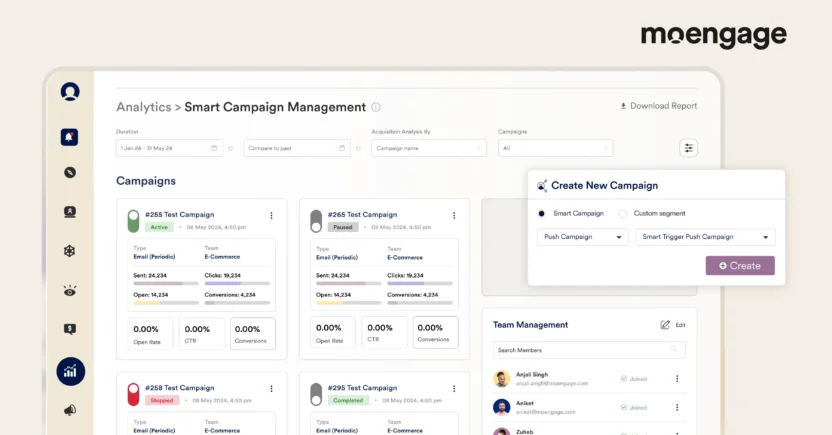
MoEngage is a comprehensive AI-driven Customer Engagement Platform (CEP) tailored for consumer brands. It offers deep analytics, real-time insights, and AI-powered automation to deliver personalized messaging across 10+ channels, including mobile push, web push, email, SMS, in-app, and WhatsApp.
How pricing works: MoEngage offers two pricing plans—the Growth plan and the Enterprise plan. The Growth plan is suited for growing teams that are looking to amplify customer engagement, while the Enterprise plan is tailored to multi-functional teams that want to create highly unique customer experiences.
Aside from this, MoEngage offers a free plan for 10K Monthly Active Users or MAUs.
Monthly Active Users (MAU) measures the number of unique users who interact with your app, website, or platform at least once a month. With MAU pricing, you pay in proportion to how many people actually use your product, not how many signed up.
Additionally, as your active user base grows, costs increase logically, making budgeting easier.
Features focused on customer engagement: Includes AI-powered campaign optimization, multivariate testing, predictive churn/conversion models, and personalized content generation via Merlin AI.
Features focused on cross-channel: Supports messaging across 10+ channels with unified customer profiles, journey orchestration, real-time campaign delivery, and personalization across touchpoints.
Best for: Brands looking to streamline and scale engagement with advanced AI targeting and automation across multiple customer touchpoints.
2. Zendesk
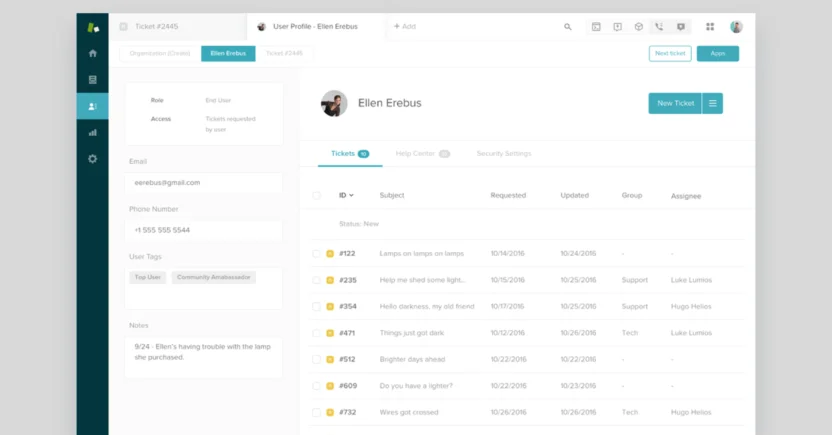
Zendesk is primarily known for customer support, but it’s also a good option for customer engagement. It brings AI, automation, and real-time messaging together so you can respond faster, personalize interactions, and keep conversations consistent across channels. Instead of juggling separate tools for support and engagement, Zendesk helps teams manage both in one place.
How pricing works: Zendesk’s customer service solution has a four-tiered pricing plan that starts at $19 per agent per month and goes all the way up to $169.
Features focused on customer engagement: Zendesk helps you engage customers in smarter ways—whether it’s through AI bots that handle common questions, tools that route people to the right agent faster, or proactive messages that reach out before a customer has to. It also gives agents more context in one place, so conversations feel seamless instead of scattered.
Features focused on cross-channel: With Zendesk, you can keep communication consistent across email, live chat, social, phone, and apps like WhatsApp. Their AI tools, like Zendesk AI and Flow Builder, let you set up automated experiences that still feel personal and adapt to how customers choose to connect.
Best for: Zendesk is a good fit for small and mid-sized businesses thanks to its easy setup and user-friendly design, but it also scales well for larger enterprises. It works best for companies that put customer experience at the center and want to unify support across channels like email, live chat, social media, and phone.
3. HubSpot CRM
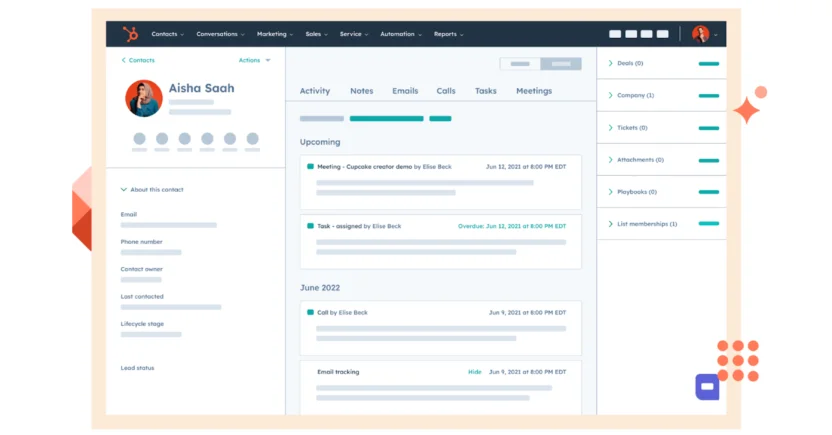
HubSpot CRM is built to bring marketing, sales, and customer service into one connected platform, making it easier for teams to manage the full customer journey. It’s popular with small to mid-sized businesses due to its easy setup and simple interface, while larger companies value it for the comprehensive integrations and flexibility it offers as their needs become more complex.
How pricing works: HubSpot’s Smart CRM offers a professional plan for $45 per month and an enterprise plan for $75 per month.
Features focused on customer engagement: HubSpot makes it simple to manage and personalize outreach with tools like lead scoring, automated email sequences, live chat, and conversation tracking. AI features help write content, score leads more accurately, and give reps recommendations so teams can spend more time building relationships instead of managing busywork.
Features focused on cross-channel: Conversations are centralized across email, chat, social media, and phone, giving teams a single view of the customer. HubSpot also integrates with a wide range of third-party apps, so businesses can connect their customer engagement workflows with the rest of their tech stack.
Best for: HubSpot CRM is best suited for growing teams that want an accessible yet powerful way to unify marketing, sales, and support. It’s used across industries like SaaS, Ecommerce, education, and professional services by companies that want a clear, connected view of their customers.
4. Klaviyo
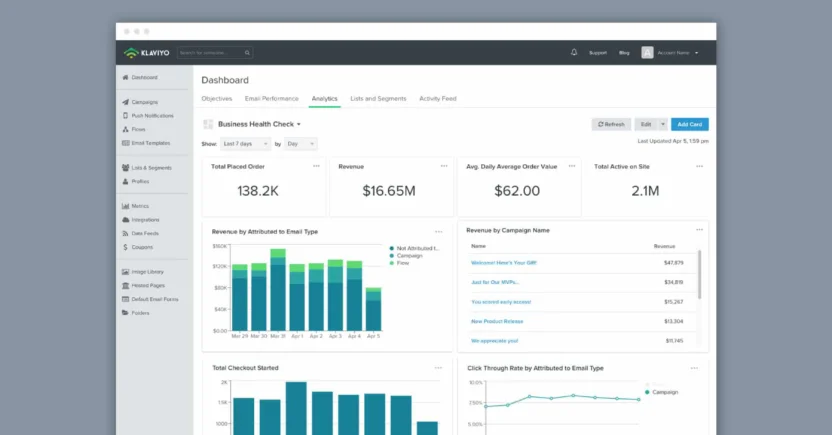
Klaviyo is a customer engagement and marketing automation platform built with B2C brands in mind. It connects directly with platforms like Shopify, WooCommerce, and BigCommerce, helping brands turn customer data into targeted, personalized messages across email, SMS, and mobile push.
How pricing works: Klaviyo offers a completely free plan with limited features. They also offer two plans priced at $45 and $60.
Features focused on customer engagement: Klaviyo shines when it comes to personalization. Brands can use Klaviyo’s advanced segmentation to target customers based on shopping behavior, lifecycle stage, or past purchases. It also includes predictive analytics to anticipate things like churn risk, expected next purchase date, or likely spending amount, helping marketers reach customers at the right time with the right message.
Features focused on cross-channel: The platform supports campaigns across email, SMS, and mobile push notifications. Its automation builder makes it easy to design flows, such as abandoned cart reminders, post-purchase follow-ups, or win-back campaigns. Real-time syncing with Ecommerce platforms ensures that campaigns are always based on the freshest customer data
Best for: Klaviyo is best suited for Ecommerce and DTC brands that want a platform tailored to their workflows. It works well for small businesses getting started with marketing automation, but also scales to support larger retailers that need deeper analytics and more advanced automation.
5. Salesforce Marketing Cloud
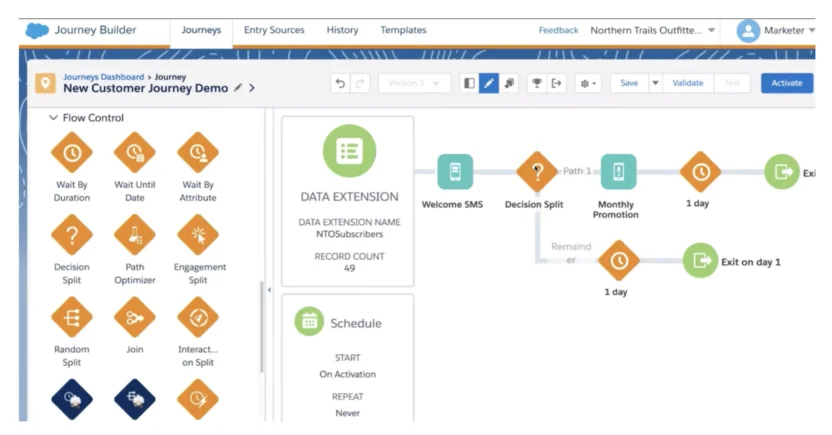
Salesforce Marketing Cloud is an enterprise-grade marketing automation platform built on their CRM. It uses unified customer data and embedded AI agents or Agentforce to automate, personalize, and orchestrate cross-channel campaigns at scale.
However, some users feel that while Salesforce Marketing Cloud Engagement offers powerful features, its high cost, especially with USD pricing and exchange rate fluctuations, can make budgeting tricky. Sometimes it can feel too expensive for smaller campaigns.
How pricing works: Salesforce Marketing Cloud offers three pricing plans. Their Starter Suite is priced at $25 per month per user, while their highest pricing tier costs $3,250 per organization per month.
Features focused on customer engagement: The platform enables marketers to know their audience deeply via unified profiles and deliver personalized experiences with AI-driven insights and two-way messaging (thanks to Agentforce). It streamlines campaign workflows from content creation to delivery and ensures messages adapt in real-time to customer intent.
Features focused on cross-channel: Salesforce Marketing Cloud supports seamless orchestration across email, mobile, ads, web, SMS, and more. Through Agentforce, journeys span the full customer lifecycle in real time and across departments, improving coordination among marketing, sales, service, and commerce teams.
Best for: Large enterprises or growth-stage companies that already operate within the Salesforce ecosystem, especially those that want to embed AI agents and data-driven personalization across multiple customer touchpoints with minimal friction.
6. Freshdesk by Freshworks
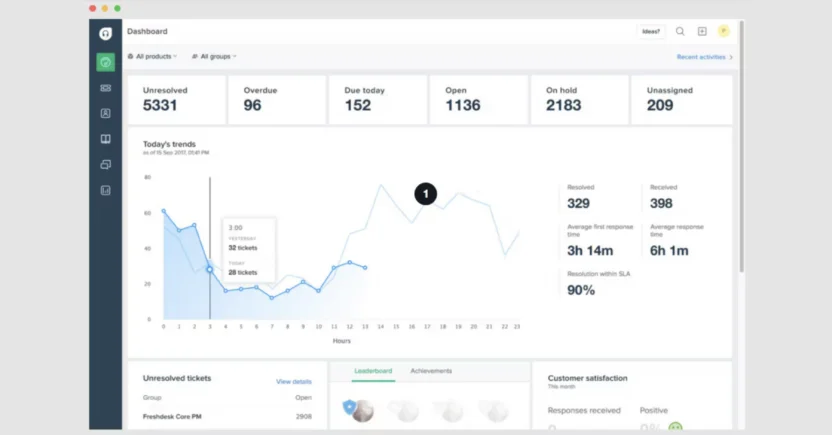
Freshdesk is a cloud-based customer support platform that centralizes inquiries from email, chat, social media, phone, and more into one intuitive helpdesk interface. It’s designed to simplify support workflows while empowering teams with AI-driven automation and self-service tools.
How pricing works: Freshdesk offers a free plan for up to 10 agents. Their Growth plan starts at $15 per agent per month, and their Enterprise plan is priced at $79 per month per agent.
Features focused on customer engagement: Freshdesk includes a robust ticketing system, automation workflows, SLA management, collaboration tools, and a built-in knowledge base to streamline agent efficiency. Its AI suite (Freddy AI) enhances productivity with features like smart ticket triage, AI email bots, response suggestions, ticket summarization via Copilot, and actionable insights, including a “Thank You Detector” to prevent unnecessary ticket reopens.
Features focused on cross-channel: Freshdesk supports unified customer interactions across email, chat, phone, social media, and messaging apps via its omnichannel plans. These features include bot sessions, real-time dashboards, customizable portals, multilingual support, intelligent routing, and integrations with support channels like WhatsApp.
Best For: Organizations that need a scalable, user-friendly support platform with powerful automation and AI enhancements. Those requiring seamless engagement across multiple channels will especially benefit from its omnichannel editions.
7. Drift
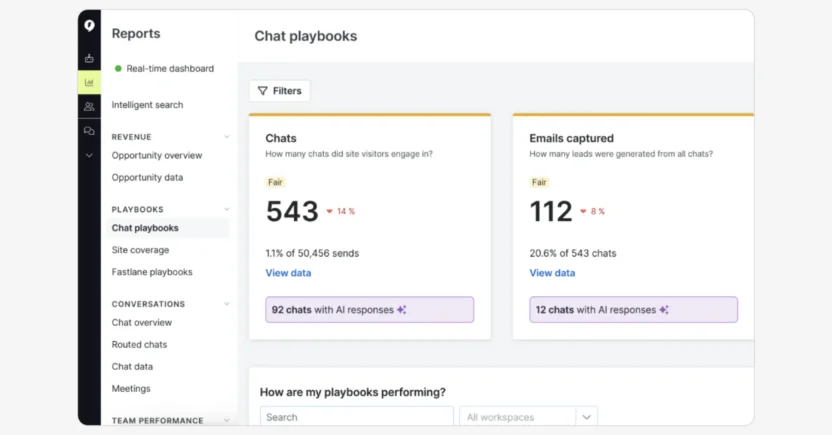
Drift is an AI-powered conversational marketing and sales platform (now integrated into Salesloft) that transforms website engagement into meaningful buyer interactions. It offers live chat agents, AI-driven chatbots, and conversational workflows that drive pipeline and close sales faster.
How pricing works: Drift’s pricing starts at $2,500 per month and offers custom pricing for more complex requirements.
Features focused on customer engagement: Drift engages visitors with human-like AI chatbots that deliver on-brand, personalized responses, even to open-text questions, 24/7. These bots are trained on your brand content and can qualify leads before routing them into your Salesloft Cadence.
Features focused on cross-channel: Drift’s chatbots can handle common questions, qualify leads, and book meetings automatically, freeing up sales reps to focus on high-value conversations. They also learn from past interactions, offering more personalized, on-brand responses over time. For teams that want deeper insight, Drift provides analytics on chat performance and buyer behavior.
Best for: Drift is best suited for B2B sales and marketing teams that want to capture and convert website visitors through real-time, AI-powered conversations, especially high-intent buyers, while seamlessly feeding those leads into their sales workflows. Since it’s designed with B2B pipelines in mind, it’s less effective for B2C marketers who usually prioritize large-scale, cross-channel engagement over one-to-one lead qualification.
8. Ada
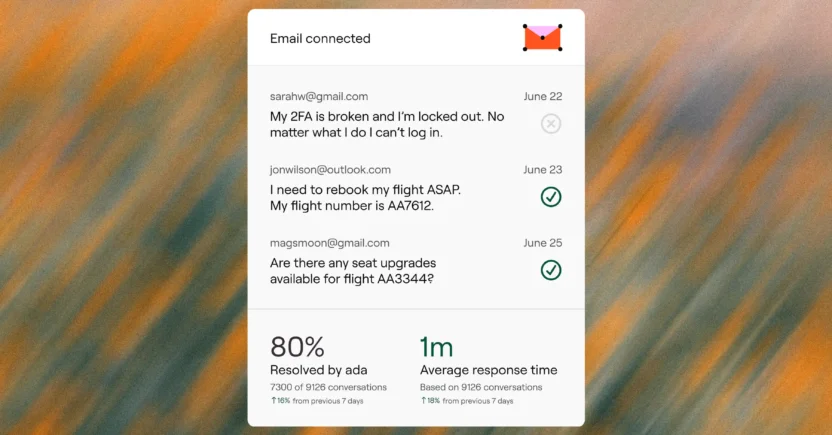
Ada is an AI-powered customer service automation platform that enables businesses to deploy intelligent AI agents across chat, voice, and email. Its core is the Ada Reasoning Engine, designed to understand intent, retrieve knowledge, create action plans, and resolve customer inquiries efficiently and accurately.
How pricing works: Ada offers custom pricing based on your requirements.
Features focused on customer engagement: Ada supports no-code automation—letting you build, train, and optimize AI agents without needing technical help. You can simulate dialogues, test performance, coach agents to follow your SOPs, and continuously train the system for accuracy and brand-aligned responses.
Features focused on cross-channel: Ada works across multiple languages (50+) and connects with messaging, voice, and email channels. It integrates with tools like Salesforce, Twilio, and Contentful, ensuring seamless communication across platforms and real-time contextual support.
Best for: Organizations looking to scale support through AI, especially those needing multilingual, omnichannel automation and 24/7 support without massive developer overhead. Ada suits enterprises aiming for self-service excellence and consistent customer experiences across every touchpoint.
MoEngage AI is Built for Seamless Customer Engagement
In our recent joint study with G2, we found that AI in Customer Engagement is evolving beyond automation, with intelligent AI agents handling complex marketing tasks autonomously. When it comes to AI in customer engagement, the concept is no longer just a theory— real-world marketers are using this technology to drive smarter, faster, and more personal customer experiences. With MoEngage’s AI-powered Customer Engagement Platform, brands can go beyond manual campaigns and embrace predictive insights, automated optimization, and generative creativity that scale effortlessly across every channel.
If you’re ready to see how MoEngage AI can transform your customer engagement, book a demo today.

